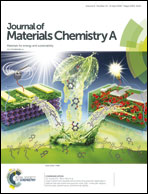Central dicyanomethylene-substituted unsymmetrical squaraines and their application in organic solar cells†
Abstract
By dicyanomethylenation on the central squaric acceptor core, three unsymmetrical squaraines (USQ), namely diCN-USQ-1–3, were synthesized, and in-depth comparative studies between them and their reference compounds (USQ-1–3) were carried out. The results indicate that the presence of dicyanomethylene groups on the central squaric ring will lead to distinctly altered properties on the entire π-conjugated system of the fluorophore, such as lowering of the optical bandgap, deepening of the HOMO energy level, increasing of the dipole moment and changing on the dipole moment direction. Consequently, solution-processed bulk-heterojunction small molecule organic solar cells (BHJ-SMOSCs) using these diCN-USQs as electron donor materials could simultaneously show much enhanced open-circuit voltage and significantly increased short-circuit current density, and hence drastically higher power conversion efficiencies (PCEs) than their corresponding USQ-based reference devices (PCE: 1.46%, 1.91%, and 4.58% for diCN-USQ-1–3, and 0.45%, 0.77%, and 3.05% for USQ-1–3 in sequence). Note that the diCN-USQ-3-based device shows a PCE of 4.58%, which is the highest value among all the reported organic solar cells based on centrally substituted squaraines.



 Please wait while we load your content...
Please wait while we load your content...